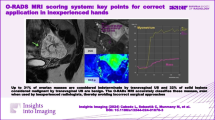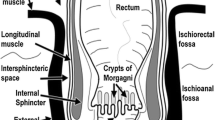Abstract
Background
Adhesions are a well-known and very common complication to surgery. Their extent and severity varies according to type and number of surgeries, use of intraabdominal mesh, and presence of peritonitis. Adhesions cause increased morbidity and mortality, with subsequent socioeconomic consequences. This review aimed to identify existing literature on noninvasive radiologic techniques for identification of intraabdominal adhesions.
Methods
A structured literature search of medical databases was conducted. English literature published until September 2009 and relevant references were included and assessed.
Results
The search identified transabdominal ultrasonography (TAU) and cine magnetic resonance imaging (cine MRI) as relevant tools matching the search criteria. In all, 12 publications concerning TAU and 4 publications concerning cine MRI were identified. All but one of these publications had the methodologic limitation of not being blinded, which influenced the final sensitivity, specificity, and accuracy.
Conclusion
Both TAU and cine MRI seem able to identify intraabdominal adhesions using visceral slide with accuracy of 76% to 92%. Unfortunately, the studies are biased by being nonblinded. Accordingly, a need exists for a systematic well-conducted double-blinded comparative study to validate these radiologic techniques.
Similar content being viewed by others
References
Levrant SG, Bieber EJ, Barnes RB (1997) Anterior abdominal wall adhesions after laparotomy or laparoscopy. J Am Assoc Gynecol Laparosc 4:353–356
Ellis H, Moran BJ, Thompson JN, Parker MC, Wilson MS, Menzies D, McGuire A, Lower AM, Hawthorn RJ, O’Brien F, Buchan S, Crowe AM (1999) Adhesion-related hospital readmissions after abdominal and pelvic surgery: a retrospective cohort study. Lancet 353:1476–1480
Tingstedt B, Isaksson J, Andersson R (2007) Long-term follow-up and cost analysis following surgery for small bowel obstruction caused by intra-abdominal adhesions. Br J Surg 94:743–748
van GH (2007) Consequences and complications of peritoneal adhesions. Colorectal Dis 9(Suppl 2):25–34
Sasaki M, Kawabe M, Hirai S, Yamada N, Morioka K, Ihaya A, Tanaka K (2005) Preoperative detection of pleural adhesions by chest ultrasonography. Ann Thorac Surg 80:439–442
Balique JG, Benchetrit S, Bouillot JL, Flament JB, Gouillat C, Jarsaillon P, Lepere M, Mantion G, Arnaud JP, Magne E, Brunetti F (2005) Intraperitoneal treatment of incisional and umbilical hernias using an innovative composite mesh: four-year results of a prospective multicenter clinical trial. Hernia 9:68–74
Bingener J, Kazantsev GB, Chopra S, Schwesinger WH (2004) Adhesion formation after laparoscopic ventral incisional hernia repair with polypropylene mesh: a study using abdominal ultrasound. JSLS 8:127–131
Aube C, Pessaux P, Tuech JJ, du PR, Becker P, Caron C, Arnaud JP (2004) Detection of peritoneal adhesions using ultrasound examination for the evaluation of an innovative intraperitoneal mesh. Surg Endosc 18:131–135
Arnaud JP, Hennekinne-Mucci S, Pessaux P, Tuech JJ, Aube C (2003) Ultrasound detection of visceral adhesion after intraperitoneal ventral hernia treatment: a comparative study of protected versus unprotected meshes. Hernia 7:85–88
Fischer T, Ladurner R, Gangkofer A, Mussack T, Reiser M, Lienemann A (2007) Functional cine MRI of the abdomen for the assessment of implanted synthetic mesh in patients after incisional hernia repair: initial results. Eur Radiol 17:3123–3129
van der Wal JB, Jeekel J (2007) Biology of the peritoneum in normal homeostasis and after surgical trauma. Colorectal Dis 9(Suppl 2):9–13
Duron JJ (2007) Postoperative intraperitoneal adhesion pathophysiology. Colorectal Dis 9(Suppl 2):14–24
Voskerician G, Jin J, Hunter SA, Williams CP, White M, Rosen MJ (2009) Human peritoneal membrane reduces the formation of intra-abdominal adhesions in ventral hernia repair: experimental study in a chronic hernia rat model. J Surg Res 157:108–114
diZerega GS, Campeau JD (2001) Peritoneal repair and postsurgical adhesion formation. Hum Reprod Update 7:547–555
Holmdahl L (1997) The role of fibrinolysis in adhesion formation. Eur J Surg Suppl (577):24–31
Ellis H (1971) The cause and prevention of postoperative intraperitoneal adhesions. Surg Gynecol Obstet 133:497–511
Sigel B, Golub RM, Loiacono LA, Parsons RE, Kodama I, Machi J, Justin J, Sachdeva AK, Zaren HA (1991) Technique of ultrasonic detection and mapping of abdominal wall adhesions. Surg Endosc 5:161–165
Borzellino G, De MG, Ricci F (1998) Detection of abdominal adhesions in laparoscopic surgery: a controlled study of 130 cases. Surg Laparosc Endosc 8:273–276
Caprini JA, Arcelus JA, Swanson J, Coats R, Hoffman K, Brosnan JJ, Blattner S (1995) The ultrasonic localization of abdominal wall adhesions. Surg Endosc 9:283–285
Hsu WC, Chang WC, Huang SC, Torng PL, Chang DY, Sheu BC (2006) Visceral sliding technique is useful for detecting abdominal adhesion and preventing laparoscopic surgical complications. Gynecol Obstet Invest 62:75–78
Kodama I, Loiacono LA, Sigel B, Machi J, Golub RM, Parsons RE, Justin J, Zaren HA, Sachdeva AK (1992) Ultrasonic detection of viscera slide as an indicator of abdominal wall adhesions. J Clin Ultrasound 20:375–380
Kolecki RV, Golub RM, Sigel B, Machi J, Kitamura H, Hosokawa T, Justin J, Schwartz J, Zaren HA (1994) Accuracy of viscera slide detection of abdominal wall adhesions by ultrasound. Surg Endosc 8:871–874
Kothari SN, Fundell LJ, Lambert PJ, Mathiason MA (2006) Use of transabdominal ultrasound to identify intraabdominal adhesions prior to laparoscopy: a prospective blinded study. Am J Surg 192:843–847
Marin G, Bergamo S, Miola E, Caldironi MW, Dagnini G (1987) Prelaparoscopic echography used to detect abdominal adhesions. Endoscopy 19:147–149
Steitz HO, Meyer G, Schildberg FW (1997) Ultrasonography of adhesions prior to laparoscopic procedures after previous abdominal operations: current aspects of laparoscopic colorectal surgery. Springer, New York, pp 210–216
Tan HL, Shankar KR, de-Ajayi N, Guelfand M, Kiely EM, Drake DP, De BR, McHugh K, Smith AJ, Morris L, Gent R (2003) Reduction in visceral slide is a good sign of underlying postoperative viscero-parietal adhesions in children. J Pediatr Surg 38:714–716
Tu FF, Lamvu GM, Hartmann KE, Steege JF (2005) Preoperative ultrasound to predict infraumbilical adhesions: a study of diagnostic accuracy. Am J Obstet Gynecol 192:74–79
Uberoi R, D’Costa H, Brown C, Dubbins P (1995) Visceral slide for intraperitoneal adhesions? A prospective study in 48 patients with surgical correlation. J Clin Ultrasound 23:363–366
Lienemann A, Sprenger D, Steitz HO, Korell M, Reiser M (2000) Detection and mapping of intraabdominal adhesions by using functional cine MR imaging: preliminary results. Radiology 217:421–425
Katayama M, Masui T, Kobayashi S, Ito T, Sakahara H, Nozaki A, Kabasawa H (2001) Evaluation of pelvic adhesions using multiphase and multislice MR imaging with kinematic display. AJR Am J Roentgenol 177:107–110
Buhmann-Kirchhoff S, Lang R, Kirchhoff C, Steitz HO, Jauch KW, Reiser M, Lienemann A (2008) Functional cine MR imaging for the detection and mapping of intraabdominal adhesions: method and surgical correlation. Eur Radiol 18:1215–1223
Lang RA, Buhmann S, Hopman A, Steitz HO, Lienemann A, Reiser MF, Jauch KW, Huttl TP (2008) Cine-MRI detection of intraabdominal adhesions: correlation with intraoperative findings in 89 consecutive cases. Surg Endosc 22:2455–2461
Acknowledgements
Disclosures
Nellie B. Zinther, Jens Fedder, and Hans Friis-Andersen have no conflicts of interest or financial ties to disclose.
Author information
Authors and Affiliations
Corresponding author
Rights and permissions
About this article
Cite this article
Zinther, N.B., Fedder, J. & Friis-Andersen, H. Noninvasive detection and mapping of intraabdominal adhesions: a review of the current literature. Surg Endosc 24, 2681–2686 (2010). https://doi.org/10.1007/s00464-010-1119-6
Received:
Accepted:
Published:
Issue Date:
DOI: https://doi.org/10.1007/s00464-010-1119-6




